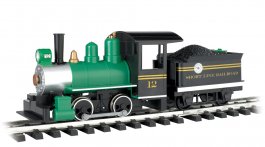Update:
Oldest Son and I mounted both motors and the after coupler. All good. I was going to try to use heat shrink tubing to thicken up the axels to mount the wheels, but I could not locate any of the ladies’ hair dryers. Go figure…usually I am tripping over the things. Still, this effectively divides the project into two parts we can tackle in parallel. The first is getting power to the motors. The second is putting cosmetic details on the external shell.
I had an opportunity to address the latter, adding forest-green boiler bands. Both Nisei participated. This means that there is about a 90 year spread between youngest and oldest contributors to this project! I have some brass paint on hand for visible handwheels and the steam relief. I am curious if the simulated “dogs” (naval term) holding shut the smokebox should be brass as well. I am also seriously contemplating dry erase or decals for this project. We’ll see.
I also spoke at length with “Auntie.” Unfortunately, my book “Plantation Railways on Kauai and the Remaining Islands” gives only passing coverage to the Maui sugar haulers. Her family worked the Hawaiian Commercial & Sugar Co., which had a pair of 0-4-0 Baldwin, 5x 0-6-0 Porters, and 2x 25 ton diesels as of 1946. Unfortunately, she worked fields serviced by trucks. She did remember seeing the “grabs” filling the small cane cars, though, and, when she saw a picture of a rival company’s 0-4-2T, she said it was pretty representative of what she remembers…little steam engines with bells, whistles, and headlamps. She did say, “Eh! Never once seen one that clean!” I have the little steam engine, so I am ahead! Auntie promised to dig for photos and to refresh her memory on the topic, as she had not thought about it for a long time. Interestingly, she did have memory of riding the Kahalui RR to the fair. As for Uncle, he sat and watched North Star pull its Christmas consist, but his journey through yesterday remained internal as it always does whenever he watches the Triple O or leafs through my Hawaii railroad books. There is a story in there somewhere…One day, I hope to get it.
Back to the project…
- Missing bits. It seems Little Thomas will need a bell, whistle, and headlamp.
- Missing marks. Loco number, name, and company were common on locos. With luck, the local craft shop will have dry transfer letters.
- Missing paint. I could use some help here, as all of my photos are black and white. Clearly, the steam relief - or at least the springs - and the visible handwheels should be brass, and the wheel flanges, hand holds, and foot holds, should get some silvering. What else should I be looking for? Also, should I use gloss black for the simulated coal load, or sprinkle in some crushed charcoal form the grill? Finally, should I just leave the old boy solid black? I have a color print of a plantation train in green paint, and most seem to have had silver smoke boxes. The latter would look contrived, but I was dickering with the idea of painting the roof green. Then again, maybe by the time this is touched up, detailed, and weathered it will look fine.
-
- Drive train. A geared loco remains the easiest way to get some motion on the lower hull. Everything would be static, except for “chains” running up from the driver wheels around idlers free spinning around a dummy drive sprocket. I still have to iron out how to make the cylinders look like they drive that drive sprocket. I’ve spent some time looking at pictures of geared locomotives, and it seems some of the “guts” were not always visible, so I am wondering if “less is more” may be the way to go.
And that’s a wrap! Little Thomas will go back on the shelf in one piece, waiting only for me to figure out the wiring to bring his new motors to life. After that push to get him running, it’ll be all about finishing his transformation from broken toy to operating model!
Happy New Year and Have a Great Week!
Eric
